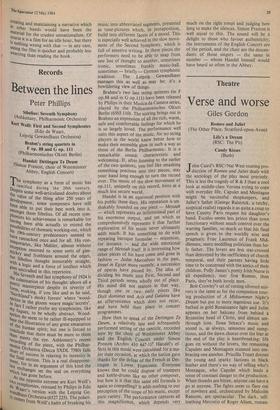Records
Between the lines
Peter Phillips
The symphony as a form of music has ramified during the 20th century. Despite some well-articulated doubts about the value of the thing after 250 years of development, some composers have still been able to put their best work into it, amongst them Sibelius. Of all recent sym- ronists his achievement is remarkable for having been able actually to extend the his Possibilities of thematic working-out, which 19th-century predecessors seemed to have ransacked once and for all. His con- temporaries, like Mahler, almost without exception resorted to some sorts of gim- 1ickry and frothiness around the edges, 11)11It Sibelius thought inexorably straight, with a logic and a force of intellect which goes unrivalled in this repertoire. th "is Seventh and last symphony of 1924 is he culmination of his thought: above all a Poeticmasterpiece despite its severity of o Luirrirt,hevnodking, if you like and as he said,
N ia
s dusky forests' where 'wood- s'prites in the gloom weave magic secrets'. mlo fact I rather prefer my symphonies, like sy fugues, to be wholly abstract. Wood- Drites do seem to be rather ill-equipped to bear the illustration of any great emanation ef the human spirit; but one is forced to than that there must be more to them Ian meets the eye. Ashkenazy's recent raecording of the piece, with the Philhar- sh°Ma Orchestra (Decca SXDL 7580) falls 0113" of success in relaxing its intensity in ,.,se final section. This is a real disappoint- ment, for in an argument of this kind the wi_st. exchanges set the seal on everything
nich has gone before.
rwAt the opposite extreme are Kurt Weill's de°„.sYmPhonies, reissued by Philips in Edo w_ waart's version with the Leipzig Ge- b"illdhaus Orchestra (6527 225). The polari- 'Y comes from Weill's habit of breaking his
music into abbreviated segments, presented as tone-pictures which, in juxtaposition, build into different facets of a mood. This is especially well achieved in the slow move- ment of the Second Symphony, which is full of emotive writing.. In these pieces the performers need to be able to snap from one line of thought to another, sometimes ironic, sometimes frankly music-hall, sometimes — briefly — German symphonic tradition. The Leipzig Gewandhaus manages this as well as may be: it's a bewildering view of things.
Brahms's two late string quintets (in F op.88 and in G op,11 I) have been released by Philips in their Musica da Camera series, played by the Philharmonisches Oktett Berlin (6503 110). The scoring brings out in Brahms an expression of all the rich, warm, safe and comfortable feelings for which he is so largely loved. The performance well suits this aspect of the music, for no string players in the world know better how to make their ensemble glow in such a way as those of the Berlin Philharmonic. It is a
remarkable sound: characteristic and welcoming. If, after listening to the earlier
of the two quintets, you feel like smashing something precious into tiny pieces, stay your hand long enough to turn the record over. The music of the slow movement of op.1 1 1 , uniquely on this record, hints at a much less secure world.
Handel is in an equivocal position with his public these days. His reputation is un- shakably founded on one piece — Messiah
— which represents an infinitesimal part of his enormous output, and yet which so
comprehensively represents it that further exploration of his music never ultimately adds much. It has something to do with repeating baroque formulae — sequences, for instance — and the wide emotional range of Messiah itself. It is interesting how other pieces of his have come and gone in fashion — Judas Maccabeus in the past, Israel in Egypt more recently, a succession of operas have passed by. The idea of dividing his music into First, Second and Third periods seems wholly out of place.
His mind did not mature in that way, though one or two early pieces like Dixit dominus and Acis and Galatea have
an effervescence which does not recur, and have held their place in concert programmes.
How then to speak of the Dettingen Te Deum, a relatively late and infrequently performed setting of the canticle, recorded now by the choir of Westminster Abbey and the English Concert under Simon Preston (Archiv 410 647-1)1 Handel's ef- fects in this music were calculated for a ma- jor state occasion, at which the nation gave thanks for the defeat of the French at Det- tingen in Lower Franconia. Everyone knows that he could dispose of trumpets and kettle-drums like no other composer,
but how is it that this same old formula is again so compelling? It adds nothing to our
perception of the scope of his music, except pure variety. The performance captures all this magnificence, which depends very much on the right tempi and judging how long to make the silences. Simon Preston is well equal to this. The sound will be a delight to those who favour authenticity; the instruments of the English Concert are of the period, and the choir are the descen- dants of those singers — the same in number — whom Handel himself would have heard so often in the Abbey.






































 Previous page
Previous page